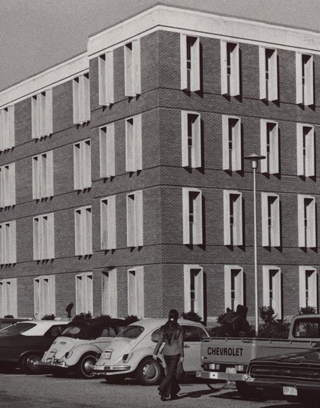
In 1970, a new Social Studies building was constructed on the former location of College Stadium (the original football stadium) next to Christenbury Memorial Gymnasium off of Tenth Street.1 The new 118,456 gross square foot facility, comprised of approximately 80,000 square feet, was the largest on campus at the time.2 While legends concerning the building’s architecture hint that the fortress-style design resulted from a turbulent campus atmosphere during the construction period, the stone shutters, narrow windows, and enclosed courtyard were actually an attempt to keep heating and cooling costs low.3
The Social Studies building was dedicated in honor of Lawrence F. Brewster on January 20, 1974. Brewster, a New York City native, was a popular professor at East Carolina, serving as director of graduate studies in history as well as a Fulbright advisor.4
- Other names
- Classroom Building, Social Sciences Building
- Built
- 1970
- Construction cost
- $2,739,443
- Gross sq. ft.
- 126,666 total
- Assignable sq. ft.
- 80,013 total
- Architects
- Jesse M. Page & Associates, Raleigh, NC
- Namesake
- Lawrence Fay Brewster (1907-1999) was educated in the public schools of New York and New Jersey. His undergraduate studies were conducted at William and Mary College, and his graduate studies at Princeton and Columbia Universities. In 1932 he received his M.A., and later a Ph.D. at Duke University (1942). For two years he held positions at Cranleigh School for Boys in St. Petersburg, Florida. He was a research editor for the North Carolina Historical Survey and for one year taught history at Clemson College. After serving at Duke University for four years, he joined the department of Social Studies at ECU as an instructor (1945). During his 25 years at ECU, Brewster initiated the Graduate Program in History, was director of Graduate Studies in History, and was a Fulbright Advisor.
Dr. Brewster held memberships in a number of organizations including Phi Beta Kappa, Phi Kappa phi, Pi Gamma Mu, American Historical Association, Southern Historical Association and the South Carolina Historical Association.After his retirement, Brewster’s commitment to ECU was still strong. He established the Lawrence F. Brewster Graduate Fellowship in History and the History Endowment Fund. Later he established the Lawrence F. Brewster Fund in the Department of History, in which each year three outstanding graduate students in history receive Brewster Fellowships.
- History
- Brewster Building was dedicated on January 20, 1974. The building is located on the north side of East Tenth Street. Built during the 60’s, a turbulent campus political period, it was designed to provide an exit from each floor onto a courtyard. The building was built as a fortress around an O-shaped courtyard and consists of four units referred to as A, B, C, and D. The windows have small slits in them so that no one can climb in or out and the windows also have stone shutters so that no one can see in or out unless they are right in front of them. The staircases were built so that they concealed themselves from the outside of the building. It also has a generator that can support the whole building and the metal gates can be lowered quickly to shut anyone from the outside out. The exterior of the structure is built from face brick cavity walls with concrete block backup at areas B, C, and D. Brewster Building currently contains the departments of History, Geography, Philosophy, Political Science, Sociology, and Economics.
- Additions
- 1965 – Dedication of the A.D. Frank Seminar room in the History Department
1993 – Reroofed building
July 1994- Landscape work done around building
1998- Masonry repair $19,500
1998- Air conditioner repairs
Soruces
1 ECU Catalog 1972-1973; “Aerial View of ECC Main Campus,” 1960 55-01-0681 https://digital.lib.ecu.edu/10186.
2 “Facilities Profile and 10-Year Capital Plan, 1999,” East Carolina University, https://www.northcarolina.edu/sites/default/files/documents/ecu_profile.pdf, p. 26.
3 “Urban Legends,” East: The Magazine of East Carolina University, p. 22, http://www.piratealumni.com/s/722/images/editor_documents/pdf/060800East.pdf.
4 Batten, In Retrospect, p. 11.